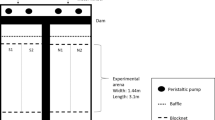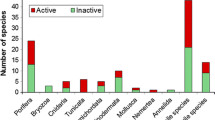Abstract
Predatory muricid gastropods,Urosalpinx cinerea, respond to specific chemical stimuli by creeping upcurrent. Attractant substances originate from living barnacles. Newly hatched snails have no prior predatory experience but respond strongly to attractants. We report here methods for rapidly extracting and desalting attractants from seawater. Attractants from living barnacles are relatively large, at least partially proteinaceous, heat-stable molecules (> 1000 but < 10000 dallons) that adsorb onto Amberlite XAD-7, a polyacrylate water purification resin, at neutral pH. Attractants remain adsorbed to the resin during a wash with deionized water and can be eluted in a small volume with 100% methanol. Attractant substances are effective in the bioassay in μg/liter concentrations (octa- to nanomolar range). Potency is destroyed by nonspecific proteases (carboxy-peptidase and pronase) but not by trypsin. Attractant is not sequestered within barnacles.
Similar content being viewed by others
References
Atema, J., 1980. Chemical senses, chemical signals, and feeding behavior in fishes, pp 57–101, in J.E. Bardach, J.J. Magnuson, R.C. May, and J.M. Reinhardt (eds.). Fish Behavior and Its Use in the Capture and Culture of Fishes. Int. Cent. Living Aquat. Res. Manag., Manila, Philippines.
Atema, J., Holland, K., andIkehara, W. 1980. Olfactory response of yellowfintuna(Thunnas albacares) to prey odors: Chemical search image.J. Chem. Ecol. 6:457–465.
Bardach, J.E. 1975. Chemoreception of aquatic animals, pp. 121–132,in D. Denton and J. Coglan (eds.). Olfaction and Taste, Vol. V. Academic Press, New York.
Blake, J. 1962. Preliminary characterization of oyster metabolites attractive to the predatory gastropodUrosalpinx cinerea. Doctoral dissertation, University of North Carolina. University Microfilms International, Ann Arbor, Michigan, 46 pp.
Carr, W.E.S., 1967a. Chemoreception in the mud snail,Nassarius obsoletus. I. Properties of stimulatory substances extracted from shrimp.Biol. Bull. 133(1):90–105.
Carr, W.E.S., 1967b. Chemoreception in the mud snail,Nassariusobsoletus. II. Identification of stimulatory substances.Biol. Bull. 133(1):106–127.
Carriker, M.R. 1955. Critical review of biology and control of oyster drillsUrosalpinx andEupleura. U.S. Dept. Int. Fish. Wildlife Serv., Spec. Scient. Rept. No. 148. 150 pp.
Castillia, J.C., 1972. Responses ofAsterias rubens: To bivalve prey in a Y-mass.Mar. Biol. 12:222–228.
Collins, A.P.S. 1975a. Biochemical investigation of two responses involved in the feeding behavior ofAcanthaster planci (L.). II. Isolation and characterization of chemical stimuli.J. Exp. Mar. Biol. Ecol. 17:69–86.
Crisp, D.J., andMeadows, P.S. 1962. The chemical basis of gregariousness inCirripedes.Proc. R. Soc. Ser. B. 156:500–520.
Fernandez, H.N., Henson, P.M., Otani, A., andHugli, T.E. 1978. Chemotactic response to human C3a and C5a anaphylatoxins I. Evaluation of C3a and C5a leukotaxis in vitro and under simulated in viro conditions.J. Immunol. 120:109–115.
Gurin, S., andCarr, W.E.S. 1974. Chemoreception inNassarius obsoletus: The role of specific stimulatory proteins.Science 174:293–295.
Hanscomb, N., Bennet, J., andHarper, G. 1976. Biochemical stimuli for feeding inAcanthaster planci (L.)J. Exp. Mar. Biol. Ecol. 22:193–197.
Jahan-Parwar, B., 1975. Chemoreception in gastropods, pp. 141–146,in D. Denton and J. Coglan (eds.). Olfaction and Taste, Vol. V. Academic Press, New York.
Jolley, R.L. 1981. Concentrating organics in water for biological testing.Environ. Sci. Technol. 158:874–880.
Ordzie, C.J., andGarafalo, G.C. 1980. Predation, attack, success, and attraction to the bay scallop,Argopecten irradians (Lamarck) by the oyster drill,Urosalpinx cinerea (Say).J. Exp. Mar. Biol. Ecol. 47:95–100.
Pratt, D.M. 1974. Attraction to prey and stimulus to attack in the predatory gastropod.Urosalpinx cinerea. Mar. Biol. 27:37–45.
Pratt, D.M. 1976. Intraspecific signaling of hunting success or failure inUrosalpinx cinerea Say.J. Exp. Mar. Biol Ecol. 21:7–9.
Rittschof, D., Williams, L., Brown, B., andCarriker, M.R. 1983. Chemoattraction of nascent oyster drills.Biol. Bull. 164:493–505.
Schiffmann, E., andGallin, J.I. 1979. Biochemistry of phagocyte chemotaxis.Curr. top. Cell. Regul. 15:203–261.
Shelton, R.G.J., andMackie, A.M. 1971. Studies on chemical preferences of the shore crab,Carcinus maenas. J. Exp. Biol. Ecol. 17:41–49.
Townsend, C.R. 1973. The food-finding orientation mechanism ofBiomphalaria glabrata(Say).Anim. Behav. 21:544–548.
Williams, L.G., Rittschof, D., Brown, B., andCarriker, M.R. 1983. Chemotaxis of oyster drillsUrosalpinx cinerea: Behavioral integration of competing stimuli.Biol. Bull. 164:536–548.
Wood, L.H. 1965. Physiological and ecologist aspects of prey selection by the marine gastropod,Urosalpinx cinerea (Say). PhD thesis, Cornell University, 216 pp.
Wood, L.H. 1968. Physiological and ecological aspects of prey selection by the marine gastropodUrosalpinx cinerea (Prosobranchia, Muricidae).Malacologia 6:267–320.
Wood, L.H.,Rittschof, D.,Williams, L.,Walsh, L., andCarriker, M.R. 1983. Olfactory conditioning of newly hatchedUrosalpinx cinerea (Say).J. Exp. Mar. Biol. Ecol. In review.
Author information
Authors and Affiliations
Rights and permissions
About this article
Cite this article
Rittschof, D., Shepherd, R. & Williams, L.G. Concentration and preliminary characterization of a chemical attractant of the oyster drill,Urosalpinx cinerea . J Chem Ecol 10, 63–79 (1984). https://doi.org/10.1007/BF00987644
Received:
Revised:
Issue Date:
DOI: https://doi.org/10.1007/BF00987644




